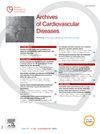Risk factors and prognosis of symptomatic postpartum ovarian vein thrombosis in two French prospective cohort studies
IF 2.3
3区 医学
Q2 CARDIAC & CARDIOVASCULAR SYSTEMS
引用次数: 0
Abstract
Introduction
Symptomatic postpartum ovarian vein thrombosis (sPOVT), an unusual site of venous thromboembolism (VTE), is a rare complication occurring in 1/500 deliveries, with uncertain prognosis.
Objective
To evaluate: (i) the risk factors for sPOVT; (ii) the short-term prognosis, in terms of extension to the inferior vena cava and the left renal and association with pulmonary embolism (PE) or deep vein thrombosis (DVT); and (iii) the risk of recurrent VTE after resuming anticoagulation.
Method
A review of all documented cases of sPOVT was conducted using data of two French multicenter prospective cohorts of 20,238 unselected pregnant women and 7102 adult patients with VTE (NCT02443610–NCT04297085). All sPOVT diagnoses, VTE recurrences and maternal deaths were reviewed and validated by an independent clinical events committee. The Ethics Committee of Brest University Hospital approved the study protocols. Written informed consent was obtained from all participants before inclusion.
Results
Among the 13 women with sPOVT, the main VTE risk factors were maternal age ≥ 35 years (n = 6;46.2%), obesity (n = 3;23.1%), VTE family history (n = 4;30.4%), multiple pregnancy (n = 3;23.1%), preterm delivery (n = 4;30.4%), caesarean delivery (n = 3;23.1%) and postpartum infection (n = 9;69.2%). At sPOVT diagnosis, four (30.8%) women presented extension to the inferior vena cava or the left renal vein. Among them, one had concomitant PE and one had thrombosis in the contralateral renal vein. None of them had concomitant DVT. During the median (IQR) follow-up of 6.1 years (3.0–7.3), after resuming anticoagulation, one patient had recurrent VTE despite thromboprophylaxis (i.e. muscular vein thrombosis after surgery five years after sPOVT) and one patient died from Hodgkin's lymphoma without VTE recurrence five years after sPOVT.
Conclusion
sPOVT appeared frequently associated with proximal clot extension and/or with PE or DVT. These observations support that sPOVT requires early diagnosis and effective anticoagulation for a minimum of three months as recommended for proximal DVT and PE. The risk of recurrence was low, so treating sPOVT similarly to provoked PE or DVT for up to six months seems appropriate. Given the close association between postpartum infection and sPOVT, the thrombotic risk needs to be regularly reassessed during postpartum.
两项法国前瞻性队列研究中产后卵巢静脉血栓形成的危险因素及预后
症状性产后卵巢静脉血栓形成(sPOVT)是一种不寻常的静脉血栓栓塞(VTE)部位,是一种罕见的并发症,发生率为1/500分娩,预后不确定。目的评价:(1)sPOVT的危险因素;(ii)短期预后,就延伸到下腔静脉和左肾以及与肺栓塞(PE)或深静脉血栓形成(DVT)的关系而言;(iii)恢复抗凝后静脉血栓栓塞复发的风险。方法采用法国两个多中心前瞻性队列(NCT02443610-NCT04297085)的数据,对所有记录在案的sPOVT病例进行回顾。该队列包括20,238名未选择的孕妇和7102名成年VTE患者。所有sPOVT诊断、静脉血栓栓塞复发和孕产妇死亡均由一个独立的临床事件委员会进行审查和验证。布雷斯特大学医院伦理委员会批准了研究方案。纳入前获得所有参与者的书面知情同意。结果13例sPOVT患者发生静脉血栓栓塞的主要危险因素为产妇年龄≥35岁(n = 6;46.2%)、肥胖(n = 3;23.1%)、静脉血栓栓塞家族史(n = 4;30.4%)、多胎妊娠(n = 3;23.1%)、早产(n = 4;30.4%)、剖宫产(n = 3;23.1%)、产后感染(n = 9;69.2%)。在sPOVT诊断中,4名(30.8%)女性表现为下腔静脉或左肾静脉延伸。其中1例合并PE, 1例对侧肾静脉血栓形成。他们都没有并发深静脉血栓。在中位(IQR)随访6.1年(3.0-7.3年)期间,恢复抗凝治疗后,1例患者尽管进行了血栓预防(即sPOVT后5年手术后肌肉静脉血栓形成),仍有静脉血栓复发,1例患者死于霍奇金淋巴瘤,sPOVT后5年无静脉血栓复发。结论spovt常伴有近端血块延伸和/或PE或DVT。这些观察结果支持sPOVT需要早期诊断和至少三个月的有效抗凝治疗,正如近端DVT和PE所建议的那样。复发的风险很低,因此将sPOVT与诱发性PE或DVT相似治疗6个月似乎是合适的。鉴于产后感染与sPOVT密切相关,需要在产后定期重新评估血栓形成风险。
本文章由计算机程序翻译,如有差异,请以英文原文为准。
求助全文
约1分钟内获得全文
求助全文
来源期刊

Archives of Cardiovascular Diseases
医学-心血管系统
CiteScore
4.40
自引率
6.70%
发文量
87
审稿时长
34 days
期刊介绍:
The Journal publishes original peer-reviewed clinical and research articles, epidemiological studies, new methodological clinical approaches, review articles and editorials. Topics covered include coronary artery and valve diseases, interventional and pediatric cardiology, cardiovascular surgery, cardiomyopathy and heart failure, arrhythmias and stimulation, cardiovascular imaging, vascular medicine and hypertension, epidemiology and risk factors, and large multicenter studies. Archives of Cardiovascular Diseases also publishes abstracts of papers presented at the annual sessions of the Journées Européennes de la Société Française de Cardiologie and the guidelines edited by the French Society of Cardiology.
 求助内容:
求助内容: 应助结果提醒方式:
应助结果提醒方式:


